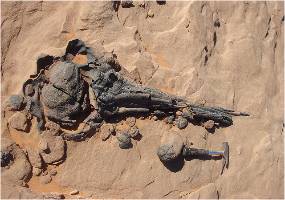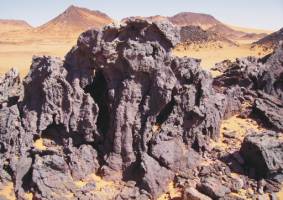|

Unique Organ Pipes in
the Gilf Kebir Crater Field (GKCF) of the Western Desert, Egypt
"Liesegang ring" Phenomenon or Hydro-volcanic
Pipes ?
"Liesegang ring" phenomenon
Periodic precipitation or the "Liesegang ring" phenomenon
is a special type of chemical pattern formations. It has been discovered by
a German chemist, Raphael Eduard Liesegang in 1896 but did not have any general
explanation more than a century ago. Several different theories have been
proposed to explain the formation of Liesegang rings. To date, however, there
is no convincing explanation.
Here are some particularly strange examples in sandstones that are associated
with this phenomenon. The idea is that sometime after a sandstone has been
deposited, for example, iron-rich surface water or groundwater has formed
concentric ringsof consolidation in repeating cycles. These tapes are said
to have piled up to pipes due to accumulation, but this has not been proven.
It is only known that there are short horizontally
embedded tubes in sandstone of Carboniferous time in Arkansas, which are have
been created by the "Liesegang ring" phenomenon.
Hydrovolcanic
pipes
The presence of unique pipes
in the Abu Ballas region in the Gilf Kebir Crater Field (GKCK), with its countless
sub-volcanic structures, speaks for the volcanic origin of this structures.
The walls of the pipes consist of a highly iron-containing quartzitic material.
The typical "Liesegang ring" pattern is missing. It is difficult to believe
that surface water or groundwater was involved in the formation of these structures.
Undoubtedly hot ferrous hydro-volcanic springs formed the pipes to compare
with the "black smokers". However, there is evidence that at least the forms
of "iron" pipes are also embedded horizontally in the sandstone. This could
mean that are lateral tubes from a vertical main hydrotherm, which is hidden
in the hills. The lateral pipes are usually hollow or almost completely clogged
with "iron".
Vertical main
pipes
Horizontal embedded
laterally pipes
Other locations:
|
Jabal Asba (Libya)
|
South of GKCF-13
(Egypt)
|
Tassili, Qued Nafeq
(Algeria)
|
|


|

|

|
|
Mourdi depression (Chad)
|
|
